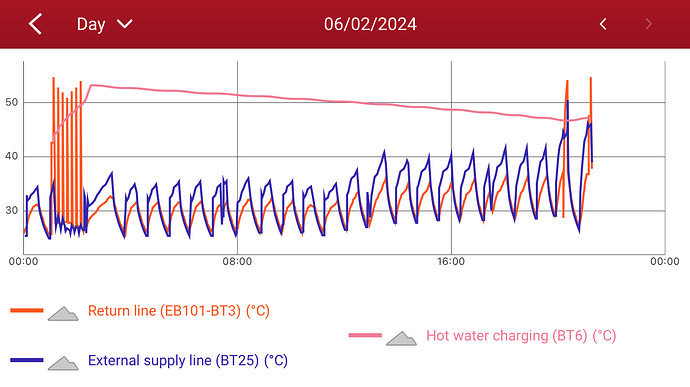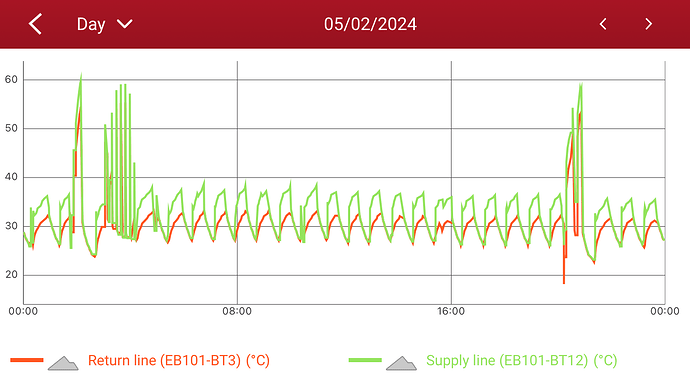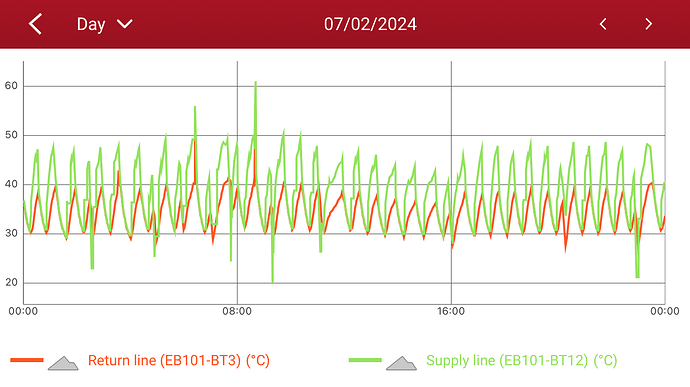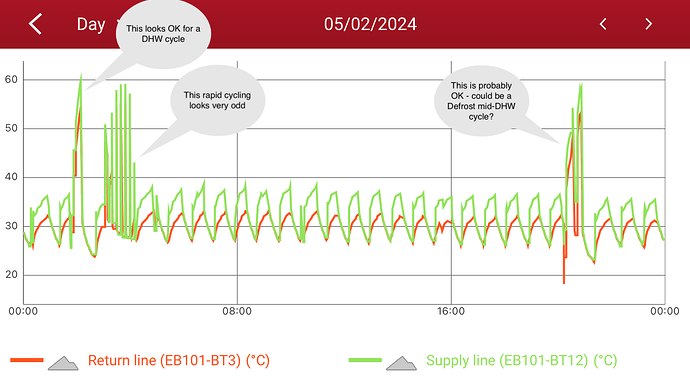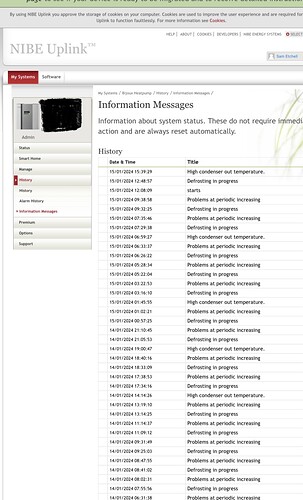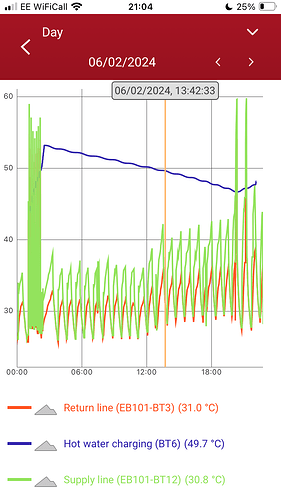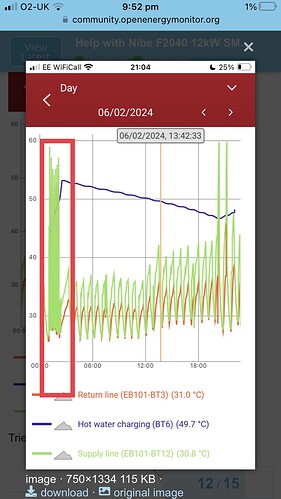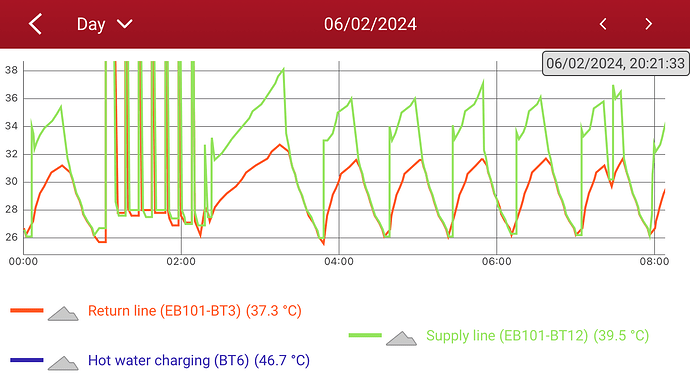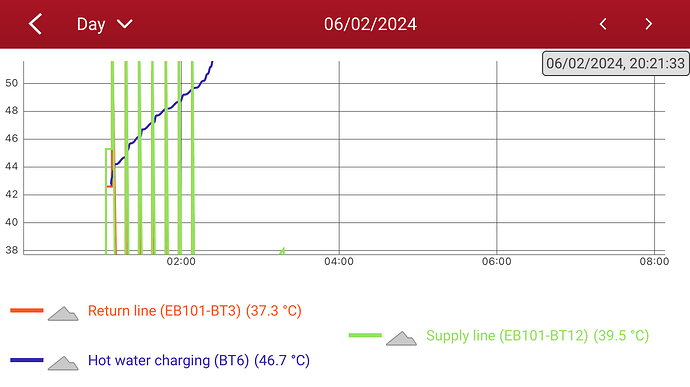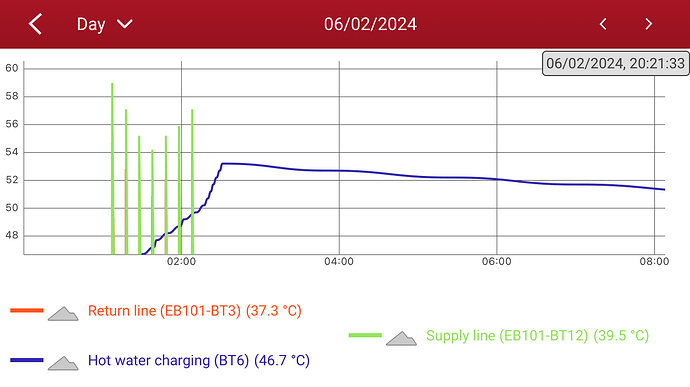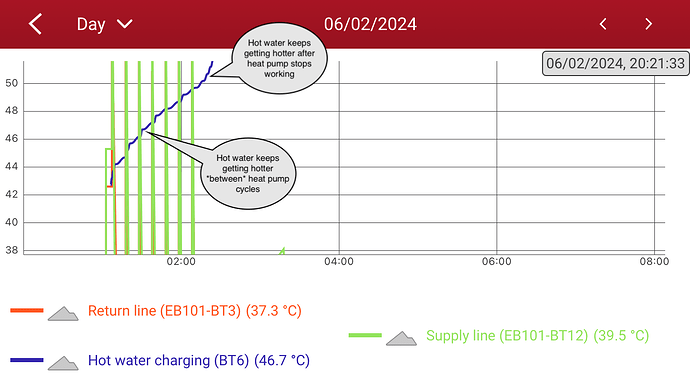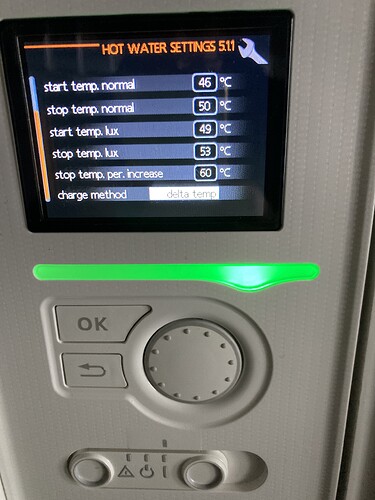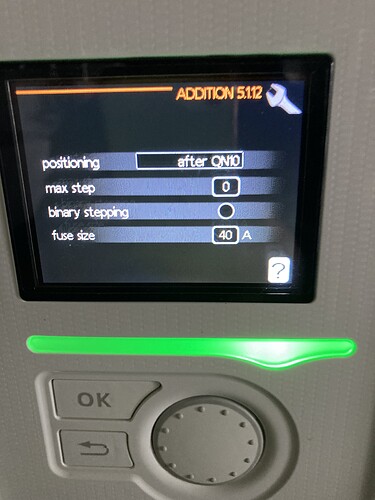I’m new to the forum - hope someone can help me with also diagnosing issues with my Nibe F2040 12kw SMO20 system too! I have had the system running since Aug 22 but it’s still not right. In particular the DHW cycles seem odd compared to what some of you folks with more experience of Nibe systems describe as normal. I’m running DHW at night when Octopus Agile is cheap but get extremely rapid cycling.
Hi Katherine
Welcome! It might be best to put this into a new thread - otherwise we risk lots of different set ups with different issues all being mixed into one giant thread.
I can see what I assume is the problem just after midnight on your graph. I would think a bit more information might be helpful. What is the plumbing set up? Do you have schematics / photos? Is it always like this? Do you have a cylinder immersion heater?
Unless the graph is misleading me, It seems like the flow temperature (blue - BT25) is around 25-30 degrees (mine goes to 55-58 degrees for DHW) and your return (orange - BT3) is cycling and a lot higher than the flow. Despite this your DHW (pink - BT6) is increasing up to temperature, is this due an additional heat source (in Nibe speak) such as an immersion heater?
The CH cycles look pretty good and what I understand as normal for a Nibe system.
I’m still quite new to understanding a Nibe system but hopefully this can kick start a discussion with some of the more experienced members.
Good idea, so I moved it to a thread of its own.
Hi Katherine,
Like Sam said, a bit more info about your plumbing set-up would be useful.
One observation is that the BT25 sensor (External (to the heat pump) supply line) is typically installed on a Buffer Tank within the Central Heating circuit, downstream of the red 3-port Diverter Valve, so it’s not ‘seeing’ the flow when that valve has switched into DHW mode.
Are you able to share a graph which plots BT12 (Condenser output temp) which is the Flow Temperature as it exits the heat pump, for us to compare with BT3 (Return temp) when in DHW mode?
Many thanks for the reply. I’ve uploaded a chart with hopefully the parameters you suggested. The heat pump was in luxury DHW mode during the night when Octopus Agile rates were very low and economy (ie didn’t run) for the rest of the time.
This shows how the heat pump runs when DHW is set to economy and with no scheduling of luxury. The op prioritisation between heating and DHW is 30 min and 30 min. However the outdoor temp is much lower on this day than the previous chart.
There is a 3kw immersion heater in the DHW cylinder. There is a red Nibe valve which controls flows between the heating circuit and the DHW cylinder and the heat pump. The heating system is all conventional radiators except for 2 kick space fan heaters in the kitchen. The heat pump replaced an old combi boiler - no changes made to the heating system apart from that. The DHW cylinder was added as there was previously no hot water cylinder.
There is a Nibe buffer vessel also
Thanks Katherine. So it’s clear it’s the Heat Pump doing the work; the Green line for BT12 (Flow) is always a higher temp than the Red line for BT3 (Return).
Like you say, the CH cycles seem OK, so I suggest a focus on the DHW aspects for now.
Here are my thoughts on your new graph:
There’s not much configuration available for DHW cycles on NIBE systems. Could you say a bit more about your DHW cylinder please - you’ve explained it’s a new install along with the heat pump so hopefully it’s a heat-pump-friendly model?
It’s always a balancing act deciding how many parameters to include on a graph and how much to zoom in/out. Including BT6 (Hot Water Charging) as on your initial graph would be helpful, and something much more zoomed-in around the rapid-cycling area might give some more clues on what’s going on there.
Do you make use of that at all or is it more of a manual back-up?
That’s presumably where the BT25 sensor is located.
it’s now obvious your HP is charging the flow up in an attempt to heat the tank and apart from cycling it seems to succeed (if it’s not your immersion actually doing the work).
When I spoke with a Nibe installer about economy and luxury settings it doesn’t change the temperature of flow out the heat pump, it just changes the target top line temperature for the water in the cylinder. So I can’t think why luxury would cause cycling but economy doesn’t, it would seem to be other factors (you mentioned outdoor temperature was different). You can plot outdoor temperature on the graphs too which might be useful data.
Whilst possibly not relevant, do you have further information (a photo is good) from the SMO20 service menu showing how your various DHW modes are configured in terms of temperature ranges. It’s in menu 5.1.1 (long press the back arrow on the controller to bring up the service menu - just in case you have not seen this before)
And sorry for more questions, have you inspected the info or alarm messages in Nibe uplink / MyUplink? It might shed some light on what the Nibe system is thinking during the cycling. It also logs defrosting events which might tie to the observations on your graph and help us understand what is and isn’t normal for your set up. Mine looks something like the below but you might be on the newer uplink system so it could be different - the same information should still be available.
It would be helpful to see a zoomed in section of flow BT12 and return BT3 alongside hot water charging BT6. I’m wondering what the delta temperature is between flow and return during a hot water cycle.
Thanks Sam. I’ve just been “upgraded” to MyUplink from Uplink and seem to have lost information logs, and also the DHW SmartControl mode, which is what I had been using.
The immersion heater is in the DHW cylinder and “should” be controlled by the wall/mounted external Nibe immersion heater controller unit, which is set to Auto, however I can’t be certain of that.
It’s very heavy snow up here in the Pennines so I’ll try to take some photos tomorrow out in the garage where all the heat pump kit and DHW cylinder are located. Really appreciate all the help and insights.
It’s most likely wired from the SMO20 controller to the immersion “controller switch box” and then onto the immersion heater element. The SMO controller will decide if it wants to use the immersion heater and In auto mode this means the immersion element is directly controlled by the SMO unit. This is what is does when the controller wants to do a periodic increase in water temperature for legionella (if configured).
The reason I ask is to understand if your flow from the heat pump isn’t charging up the hot water sufficiently (due to cycling) then it might be requesting additional heat from the immersion when in auto mode. I haven’t yet figured out the algorithm for when Nibe decides to use additional heat though. This won’t be the cause of your problem but might be an effect and could mask the problem because you have hot water (I assume). At this stage we don’t know what is happening so we are just trying to build a picture of cause and effect with lots of data and information to see if our experiences can assist.
Could you zoom further on the section highlighted by the red box? This seems to be a DHW event (judging by the flow temp peak)
Thank you. It doesn’t give me many more insights at this stage but David knows infinitely more about Nibe units so it might help him
The final graph is interesting, it seems to give up DHW effort just after 0200 but the DHW temp keeps increasing and the gradient / rate of change increases. Maybe this is indeed your immersion taking over. It’s a shame you don’t have info messages or alarms available. I get a lot of info warning messages during hot water production but never see cycling, it just runs (or defrosts) until the desired temperature (based on “DHW Comfort Mode”) is reached
maybe your service info section on the controller has something. That’s how I found my immersion was wired wrong, it never heated the water when the controller asked it to
Those further screen shots are good, thanks - especially this one:
I’ve come to the same conclusion as Sam: it seems the SMO 20 controller is bringing in the immersion heater instead of the compressor to help get the DHW tank up to temperature quickly. The manual does acknowledge this as a characteristic of the Lux DHW setting:
luxury: Lux mode gives the greatest possible amount of hot water. In this mode the immersion heater may be partially used to heat hot water, which may increase operating costs.
The surprise to me is that it’s doing this at a relatively low DHW tank temperature (45-ish?) and that it’s stopping the compressor while it’s running the immersion - you’d think it would run them in parallel if it was just trying to heat the tank quickly…?
It looks like there’s not much difference between the Flow and Return temperatures during that rapid-cycling phase, which may be giving the controller the impression it needs to use the immersion instead.
As Sam noted earlier, the Hot Water Settings in the Service Menu would be good to see; here are mine (which I don’t remember changing from the Defaults):
Good plan; I do the same (I’m on ‘Go’). Do you have a DHW Schedule set for that? How many hours is it permitted to do DHW for? (I’m wondering if a too-short time-slot might be making it think it needs to work extra-hard to get the DHW up to temp quickly, maybe???)
These are the hot water settings. Charge method was “target temp” but I have just changed this to “delta temp” - I will see if that alters anything.
These are the additional heat settings in the service menu. However I am unsure as to whether this menu actually means the immersion heater in the DHW cylinder, or whether this is for an additional external heat source (I understand in Scandinavia Nibe systems may have an electric boiler fitted to augment heat for the central heating circulation).
